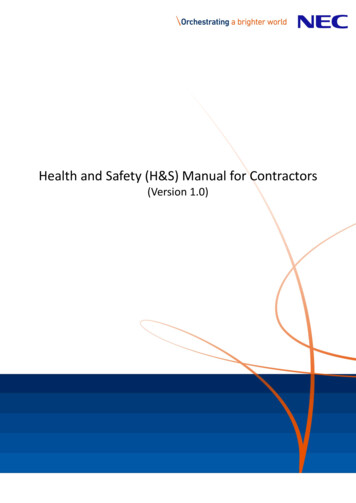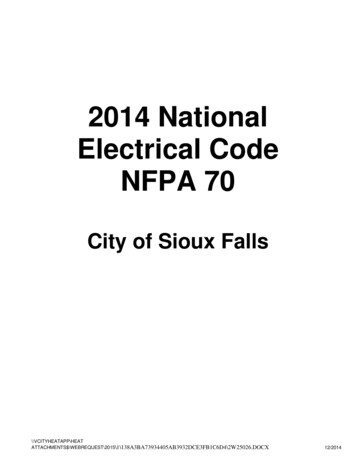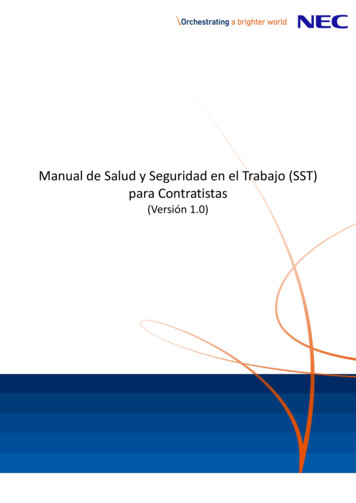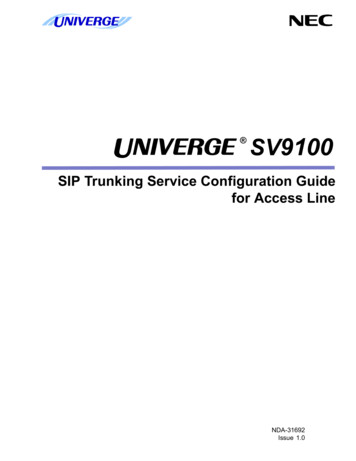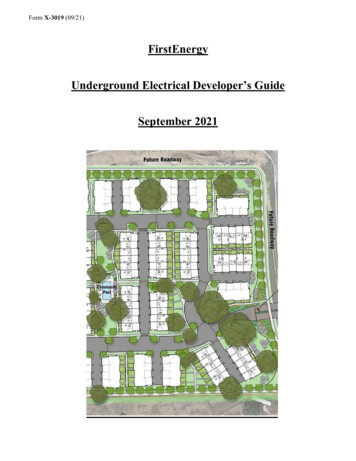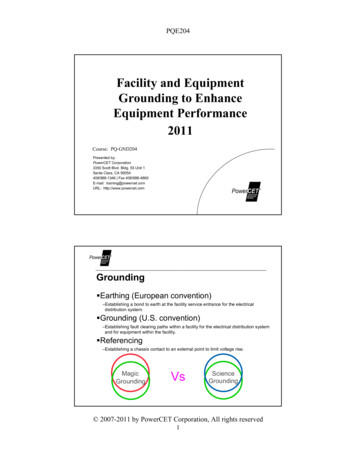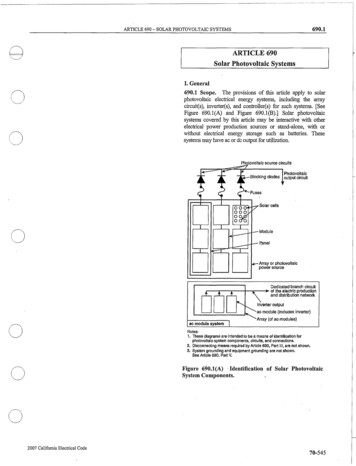
Transcription
690.1ARTICLE 690 - SOLAR PHOTOVOLTAIC SYSTEMSgooA person designated as a qualified person shall possessthe skills and knowledge related to the constructionand operation of the electrical equipment andinstallation and shall have received documented safetytraining on the hazards involved. Documentation oftheir qualifications shall be on file with the office ofthe establishment in charge of the completedinstallation.(3) Effective safeguards acceptable to the authority havingjurisdiction are established and maintained.685.3 Application of Other Articles. The articles/sectionsin Table 685.3 apply to particular cases of installation ofconductors and equipment, where there are orderlyshutdown requirements that are in addition to those of thisarticle or are modifications of them.ARTICLE 690Solar Photovoltaic SystemsI. General690.1 Scope. The provisions of this article apply to solar.photovoltaic electrical energy systems, including the arraycircuit(s), inverter(s), and controller(s) for such systems. [SeeFigure 690.1(A) and Figure 690.1 (B).] Solar photovoltaicsystems covered by this article may be interactive with otherelectrical power production sources or stand-alone, with orwithout electrical energy storage such as batteries. Thesesystems may have ac or dc output for utilization.Photovoltaic source circuitsTable 685.3 Application of Other ArticlesooooConductor/EquipmentSectionMore than one building or other225, Part IIstructureGround-fault protection of230.95, Exception No.1equipment240.4Protection of conductorsElectrical system coordination240.12Ground-fault protection of. 240.13(1)equipmentGrounding ac systems of 50250.21volts to 1000 voltsEquipment protection427.22Orderly shutdown430.44Disconnection430.74, Exception Nos. 1 and 2Disconnecting means in sight430.102(A), Exception No.2from controllerEnergy from more than one430.113,ExceptionNos.1sourceand 2Disconnecting means645.10, ExceptionUninterruptible power supplies645.11(1)(UPS)Point of connection705.12(A)Photovoltalcoutput circuitr.::- -:::-ld'-"" Solar cellsModule ne[Array or photovoltaicpower sourcer---r----:r--- ""I::""- .Dedicated branch circuitof the electric productionand distribution networkInverter outputmodule {inCludes. inverter}--' acArray (of ao modules)II. Orderly Shutdown685.10 Location of Overcurrent Devices in or onPremises. Location of overcurrent devices that are criticalto integrated electrical systems shall be permitted to beaccessible, with mounting heights permitted to ensuresecurity fl:om operation by unqualified personnel.685.12 Direct-Current System Grounding. Two-wire dccircuits shall be permitted to be ungrounded.ac module systemNotes:1. These diagrams are intended to be a means of identification forphotovoltaio system components, circuits, and connectfons,2. O.lsconnecling means required by Article GOO, Part III. are not shown,3. System grounding and equipment grounding are not shown.See Article 690. Part V.Figure 690.1(A) . Identification of Solar PhotovoltaicSystem Components.685.14 Ungrounded Control Circuits. Where operationalcontinuity is required, control circuits of 150 volts or lessfrom separately derived systems shall be permitted to beungrounded.2007 California Electrical Code70-545
690.2ARTICLE 690 - SOLAR PHOTOVOLTAIC SYSTEMS. ' IPhotovollale source circuits.Inverter Input clrcult», /Inverter output r Electrleproductionand dlstrlbu1lonPhotovoltalc output clrcultInteractlve systemnetwork connecUonInverterIWind, engine-generator,mlcro.hyoro.efectrlc, andother power sources"".---,&"'" )Energy storage, charge controller,and system controlInverter Input circuit ,verter outputPholovoltalc L.- ---Ioutput·clrcu1tHybrid systemdc foadsInverter---t.---- )"" Charge controllerPhotovallalc outputcircuitInverter Input clrcu1tInverter outputMaIn 'Stand·alone systemMalnsupply equipmentfor de loads'I . Energy storageN·oles:1. These diagrams are Intendsd to be a means of identification forphotovoltelc systemocmponents, circuits, and connections.2. DIsconnecting means and overcurrent protection required byArticle 90 are not shovm.3. System grounding and equipment grounding are not shown.See Artlc'le 90, Part V.4. Custom des'lgns occur In each configuration, and some componentsare opUonal.Figure 690.1(8) Identification of Solar Photovoltaic SystemComponents in Common System Configurations.690.2 Definitions.Alternating-Current (ac) Module (Alternating-CurrentPhotovoltaic Module). A complete, environmentallyprotected unit consisting of solar cells, optics, inverter, andother components, exclusive of tracker, designed togenerate ac power when exposed to sunlight.Array. A mechanically integrated assembly of modules orpanels with a support structure and foundation, tracker, andother components, as required, to fonn a direct-currentpower-producing unit.Bipolar Photovoltaic Array. A photovoltaic array that hastwo outputs, each having opposite polarity to a commonreference point or center tap.Blocking Diode. A diode used to block reverse flow ofcurrent into a photovoltaic source circuit.Building Integrated Photovoltaics. Photovoltaic cells,devices, modules, or modular materials that are integratedinto the outer surface or structure of a building and serve asthe outer protective surface of that building.70-546Charge Controller. Equipment that controls dc voltage ordc current, or both, used to charge a battery.Diversion Charge Controller. Equipment that regulatesthe charging process of a battery by diverting power fromenergy storage to direct-current or alternating-current loadsor to an interconnected utility service.Electrical Production and Distribution Network. Apower production, distribution, and utilization system, suchas a utility system and connected loads, that is external toand not controlled by the photovoltaic power system.Hybrid System. A system comprised of multiple powersources. These power sources may include photovoltaic,wind, micro-hydro generators, engine-driven generators,and others, but do not include electrical production anddistribution network systems. Energy storage systems, suchas batteries, do not constitute a power source for thepurpose of this definition.Interactive System. A solar photovoltaic system thatoperates in parallel with and may deliver power to anelectrical production and distribution network. For thepurpose of this definition, an energy storage subsystem of asolar photovoltaic system, such as a battery, is not anotherelectrical production source.Inverter. Equipment that is used to change voltage level orwaveform, or both, of electrical energy. Commonly, aninverter [also known as a power conditioning unit (PCU) orpower conversion system (PCS)] is a device that changesdc input to an ac output. Inverters may also function asbattery chargers that use alternating current from anothersource and convert it into direct current for chargingbatteries.Inverter Input Circuit. Conductors between the inverterand the battery in stand-alone systems or the conductorsbetween the inverter and the photovoltaic output circuitsfor electrical production and distribution network.Inverter Output Circuit. Conductors between the inverterand an ac panelboard for stand-alone systems or theconductors between the inverter and the service equipmentor another electric power production source, such as autility, for electrical production and distribution network.Module. A complete, environmentally protected unitconsisting of solar cells, optics, and other components,exclusive of tracker, designed to generate dc power whenexposed to sunlight.Panel. A collection of modules mechanically fastened together,wired, and designed to provide a field-installable unit.Photovoltaic Output Circuit. Circuit conductors betweenthe photovoltaic source circuit(s) and the inverter or dcutilization equipment.Photovoltaic Power Source. An array or aggregate ofarrays that generates dc power at system voltage andcurrent.2007 California Electrical Code
ARTICLE 690 - SOLAR PHOTOVOLTAIC SYSTEMSgPhotovoltaic Source Circuit. Circuits between modulesand from modules to the common connection point(s) ofthe dc system.Photovoltaic System Voltage. The. direct current (dc)voltage of any photovoltaic source or photovoltaic outputcircuit. For multiwire installations, the photovoltaic systemvoltage is the highest voltage between any two dcconductors.Solar Cell. The basic photovoltaic device that generateselectricity when exposed to light.CJSolar Photovoltaic System. The· total components andsubsystems that, in combination, convert solar energy intoelectrical energy suitable for connection to a utilizationload.Stand-Alone System. A solar photovoltaic system thatsupplies power independently of an electrical productionand distribution network.690.3 Other Articles. Wherever the requirements of otherarticles of this Code and Article 690 differ, therequirements of Article 690 shall apply and, ifthe system isoperated in parallel with a primary source(s) of electricity,the requirements in 705.14, 705.16, 705.32, and 705.43shall apply.oException: Solar photovoltaic systems, equipment, orwiring installed in a hazardous (classified) location shallalso comply with 500.1,505.1, and 510.1.690.4 Installation.(A) Solar Photovoltaic System. A solar photovoltaicsystem shall be pennitted to supply a building or otherstructure in addition to any service(s) of another electricitysupply system(s).ooo(B) Conductors of Different Systems. Photovoltaic sourcecircuits and photovoltaic output circuits shall not becontained -in the same raceway, cable tray, cable, outletbox, junction box, or similar fitting as feeders or branchcircuits of other systems, unless the conductors of thedifferent systems are separated by a partition or areconnected together.(C) Module Connection Arrangement. The connectionsto a module or panel shall be arranged so that removal of amodule or panel from a photovoltaic source circuit does notintenupt a grounded conductor to another photovoltaicsource circuit. Sets of modules interconnected as systemsrated at 50 volts or less, with or without blocking diodes,and having a single overcurrent device shall be consideredas a single-source circuit. Supplementary overcurrentdevices used for the exclusive protection of thephotovoltaic modules are not considered as overcurrentdevices for the purpose of this section.2007 California Electrical Code690.7(D) Equipment. Inverters or motor generators shall beidentified for use in solar photovoltaic systems.690.5 Ground-Fault Protection.Roof-mounted dcphotovoltaic arrays located on dwellings shall be providedwith dc ground-fault protection to reduce fire hazards.(A) Ground-Fault Detection and Interruption. Theground-fault protection device or system shall be capableof detecting a ground fault, interrupting the flow of faultcurrent, and providing an indication of the fault.(B) Disconnection of Conductors. The' ungroundedconductors of the faulted source circuit shall beautomatically disconnected. If the grounded conductors ofthe faulted source circuit are disconnected to comply withthe requirements of 690.5(A), all conductors of the faultedsource circuit shall be opened automatically andsimultaneously. Opening the grounded conductor of thearray or opening the faulted sections of the array shall bepennitted to interrupt the ground-fault current path.(C) Labels and Markings. Labels and markings shall beapplied near the ground-fault indicator at a visible location,stating that, if a ground fault is indicated, the normallygrounded conductors may be energized and ungrounded./690.6 Alternating-Current (ac) Modules.(A) Photovoltaic Source Circuits. The requirements ofArticle 690 pertaining to photovoltaic source circuits shallnot apply to ac modules. The photovoltaic source circuit,conductors, and inverters shall be considered· as internalwiring of an ac module.(B) Inverter Output Circuit. The output of an ac moduleshall be considered an inverter output circuit.(C) Disconnecting MEmns. A single disconnecting means,in accordance with 690.15 and 690.17, shall be pennittedfor the combined ac output of one or more ac modules.Additionally, each ac module in a multiple ac-modulesystem shall be provided with a connector, bolted, ortenninal-type disconnecting means.(D) Ground-Fault Detection. Alternating-current-modulesystems shall be permitted to use a single detection deviceto detect only ac ground faults and to disable the array byremoving ac power to the ac module(s).(E) Overcurrent Protection. The output circuits of acmodules shall be pennitted to have overClUTent protectionand conductor sizing in accordance with 240.5(B)(2).70-547
690.8ARTICLE 690 - SOLAR PHOTOVOLTAIC SYSTEMSII. Circuit Requirements690.7 Maximum Voltage.(A) Maximum Photovoltaic System Voltage. In a dcphotovoltaic source circuit or output circuit, the maximumphotovoltaic system voltage for that circuit shall becalculated as the sum of the rated open-circuit voltage ofthe series-connected photovoltaic modules corrected for thelowest expected ambient temperature. For crystalline andmulticrystalline silicon modules, the rated open-circuitvoltage shall be multiplied by the correction factorprovided in Table 690.7. This voltage shall be used todetermine the voltage rating of cables, disconnects,overcurrent devices, and other· equipment. Where thelowest expected ambient temperature is below -40 C (40 F), or where other than crystalline or multicrystallinesilicon photovoltaic modules are used, the system voltageadjustment shall be made in accordance with themanufacturer's instructions.ITable 690.7 Voltage Correction Factors for Crystallineand Multicrystalline Silicon ModulesAmbientTemperature (OC)25 to 109 to 0-1 to -10-11 to -20-21 to -40Correction Factorsfor AmbientTemperaturesBelow 25 C (77 F)(Multiply the ratedopen-circuit voltageby the appropriateAmbientcorrection factorshown below.)Temperature (OF)77 to 501.0649 to 321.1031 to 141.1313 to-41.17-5 to -401.25(B) Direct-Current Utilization Circuits. The voltage ofdc utilization circuits shall conform with 210.6.(C) Photovoltaic Source and Output Circuits. In oneand two-family dwellings, photovoltaic source circuits andphotovoltaic output circuits that do not includelampholders, fixtures, or receptacles shall be permitted tohave a maximum photovoltaic system voltage up to 600volts. Other installations with a maximum photovoltaicsystem voltage over 600 volts shall comply with Article690, Part I.(D) Circuits Over 150 Volts to Ground. In one and twofamily dwellings, live parts in photovoltaic source circuitsand photovoltaic output circuits over 150 volts to groundshall not be accessible to other than qualified persons whileenergized.FPN: See 110.27 for guarding of live parts, and 210.6 forvoltage to ground and between conductors.(E) Bipolar Source and Output Circuits. For 2-wirecircuits connected to bipolar systems, the maximum system70-548voltage shall be the highest voltage between the conductorsof the 2-wire circuit ifall of the following conditions apply:(1) One conductor of each circuit is solidly grounded.(2) Each circuit is connected to a separate subarray.(3) The equipment is clearly marked with a label asfollows:WARNINGBIPOLAR PHOTOVOLTAIC ARRAY.DISCONNECTION OF NEUTRAL ORGROUNDED CONDUCTORS MAY RESULT INOVERVOLTAGE ON ARRAY OR INVERTER.690.8 Circuit Sizing and Current.(A) Calculation of Maximum Circuit Current. Themaximum current for the specific circuit shall be calculatedin accordance with 690.8(A)(l) through (A)(4).(1) Photovoltaic Source Circuit Currents. The maximumcurrent shall be the sum of parallel module rated shortcircuit currents multiplied by 125 percent.(2) PhOtovoltaic Output Circuit Currents. The maximumcurrent shall be the sum of parallel source circuit maximumcurrents as calculated in 690.8(A)(I).(3) Inverter Output Circuit Current. The maximumcurrent shall be the inverter continuous output currentrating.(4) Stand-Alone Inverter Input Circuit Current. Themaximum current shall be the stand-alone continuousinverter input current rating when the inverter is producingrated power at the lowest input voltage.(B) Ampacity and Overcurrent Device Ratings.Photovoltaic system currents shall be considered to becontinuous.(1) Sizing of Conductors and Overcurrent Devices. Thecircuit conductors and overcurrent devices shall be sized tocarry not less than 125 percent of the maximum currents ascalculated in 690.8(A). The rating or setting of overcurrentdevices shall be permitted in accordance with 240.4(B) and (C).Exception: Circuits containing an assembly, together withits overcurrent device(s), that is listed for continuousoperation at 100 percent of its rating shall be permitted tobe utilized at 100 percent ofits rating.(2) Internal Current Limitation. Overcurrent protectionfor photovoltaic output circuits with devices that internallylimit the current from the photovoltaic output circuit shallbe permitted to be rated at less than the value calculated in690.8(B)(I). This reduced rating shall be at least 125percent of the limited current value. Photovoltaic outputcircuit conductors shall be sized in accordance with690.8(B)(1 ).Exception: An overcurrent device in an assembly listedforcontinuous operation at 100 percent of its rating shall bepermitted to be utilized at 100 percent ofits rating.2007 California Electrical Code/
690.13ARTICLE 690 - SOLAR PHOTOVOLTAIC SYSTEMS8oo(C) Systems with Multiple Direct-Current Voltages. Fora photovoltaic power source that has multiple output circuitvoltages and employs a common-return conductor, theampacity of the common-return conductor shall not be lessthan the sum of the ampere ratings of the overcurrentdevices of the individual output circuits.(D) Sizing of Module Interconnection Conductors.Where a single overcurrent device is used to protect a set oftwo or more parallel-connected module circuits, theampacity of each of the module interconnection conductorsshall not be less than the sum of the rating of the singlefuse plus 125 percent of the short-circuit current from theother parallel-connected modules.690.9 Overcurrent Protection.(A) Circuits and Equipment. Photovoltaic source circuit,photovoltaic output circuit, inverter output circuit, andstorage battery circuit conductors and equipment shall beprotected in accordance with the requirements of Article240. Circuits connected to more than one' electrical sourceshall have overcurrent devices located so as to provideovercurrent protection from all sources.Exception: An overcurrent device shall not be requiredforcircuit conductors sized in accordance with 690.8(B) andlocated where one ofthe following apply:()oo"O(a) There are no external sources such as parallelconnected source circuits, batteries, or baclifeed frominverters.(b) The short-circuit currents from all sources do notexceed the ampacity ofthe conductors.FPN: Possible backfeed of current from any source ofsupply, including a supply tlrrough an inverter into thephotovoltaic output circuit and photovoltaic source circuits,is a consideration in determining whether adequateovercurrent protection from all sources is provided forconductors and modules.(B) Power Transformers. Overcurrent protection for atransformer with a source(s)on each side shall be providedin accordance with 450.3 by considering fIrst one side ofthe transformer, then the other side of the transformer, asthe primary.Exception: A power transformer with a current rating onthe side connected toward the photovoltaic power source,not less than the short-circuit output current rating of theinverter, shall be permitted without overcurrent protectionfrom that source.(C) Photovoltaic Source' Circuits. Branch-circuit orsupplementary-type overcurrent devices shall be permittedto provide overcurrent protection in photovoltaic sourcecircuits. The overcurrent devices shall be accessible butshall not be required to be readily accessible.Standard values of supplementary overcurrent devicesallowed by this section shall be in one ampere sizeincrements, starting at one ampere up to and including 152007 California Electrical Codeamperes. Higher standard values above 15 amperes forsupplementary overcurrent devices shall be based on thestandard sizes provided in 240.6(A).(D) Direct-Current Rating. Overcurrent devices, eitherfuses or circuit breakers, used in any dc portion of aphotovoltaic power system shall be listed for use in dccircuits and shall have the appropriate voltage, current, andinterrupt ratings.(E) Series Overcurrent Protection. In series-connectedstrings of two or more modules, a single overcurrentprotection device shall be permitted.690.10 Stand-Alone Systems.The premises wiringsystem shall be adequate to meet the requirements of thisCode for a similar installation connected to a service. The. wiring on the supply side of the building or structuredisconnecting means shall comply with this Code except asmodifIed by 690.10(A), (B), and (C).(A) Inverter Output. The ac inverter output from a standalone system shall be permitted to supply ac power to thebuilding or structure disconnecting means at current levelsbelow the rating ofthat disconnecting means.(B) Sizing and Protection. The circuit conductors betweenthe inverter output and the building or structuredisconnecting means shall be sized 'based on the outputrating of the inverter. These conductors shall be protectedfrom overcurrents in accordance with Article 240. Theovercurrent protection shall be located at the output of theinverter.(C) Single l20-Volt Supply. The inverter output of astand-alone solar photovoltaic system shall be permitted tosupply 120 volts to single-phase, 3-wire, l20/240-voltservice equipment or distribution panels where there are no240-volt outlets and where there are no multiwire branchcircuits. In all installations, the rating of the overcurrentdevice connected to the output of the inverter shall be lessthan the rating of the neutral bus in the service equipment.This equipment shall be marked with the following wordsor equivalent:WARNINGSINGLE l20-VOLT SUPPLY. DO NOT CONNECTMULTIWIRE BRANCH CIRCUITSlIII. Disconnecting Means690.13 All Conductors. Means shall be provided todisconnect all current-carrying conductors of a photovoltaicpower source from all other conductors in a building orother structure. A switch or circuit breaker shall not beinstalled in a grounded conductor unless that switch orcircuit breaker is part of a ground-fault detection systemrequired by 690.5 and that switch or circuit breaker isautomatically opened and indicated as a normal function ofthe device in responding to ground faults.70-549
690.14ARTICLE 690 - SOLAR PHOTOVOLTAIC SYSTEMSFPN: The grounded conductor may have a bolted orterminal disconnecting means to allow maintenance ortroubleshooting by qualified personnel.690.14 Additional Provisions. Photovoltaic disconnectingmeansshall comply with 690.l4(A) through 690.l4(D).\(A) Disconnecting Means. The disconnecting means shallnot be required to be suitable as service equipment andshall be rated in accordance with 690.17.(B) Equipment. Equipment such as photovoltaic sourcecircuit isolating switches, overcurrent devices, andblocking diodes shall be permitted on the photovoltaic sideof the photovoltaic disconnecting means.(C) Requirements for Disconnecting Means. Means shallbe provided to disconnect all conductors in a building orother structure from the photovoltaic system conductors.(1) Location. The photovoltaic disconnecting means shallbe installed at a readily accessible location either on theoutside of a building or structure or inside nearest the pointof entrance of the system conductors.Exception: Installations that comply with 690.31(E) shallbe permitted to have the disconnecting means locatedremote from the point ofentry ofthe system conductors.The photovoltaic system disconnecting means shall notbe installed in bathrooms.I(2) Marking. Each photovoltaic system disconnectingmeans shall be permanently marked to identify it as aphotovoltaic system disconnect.(3) Suitable for Use. Each photovoltaic systemdisconnecting means shall be suitable for the prevailingconditions. Equipment installed in hazardous (classified)locations shall comply with the requirements of Articles500 through 517.(4) Maximum Number of Disconnects. The photovoltaicsystem disconnecting means shall consist of not more thansix switches or six circuit breakers mounted in a singleenclosure, in a group of separate enclosures, or in or on aswitchboard.(5) Grouping. The photovoltaic system disconnectingmeans shall be grouped with other disconnecting means forthe system to comply with 690.l4(C)(4). A photovoltaicdisconnecting memls shall not be required at thephotovoltaic module or array location.(D) Utility-Interactive Inverters Mounted in NotReadily-Accessible Locations. Utility-interactive invertersshall be permitted to be mounted on roofs or other exteriorareas that are not readily accessible. These installationsshall comply with (1) through (4):(1)A direct·current photovoltaic disconnecting meansshall be mounted within sight of or in the inverter.70-550(2) An alternating-current disconnecting means shall bemounted within sight of or in the inverter.(3)The alternating-current output conductors from theinverter and an additional alternating-currentdisconnecting means for the inverter shall comply with690.l4(C)(l).(4) A plaque shall be installed in accordance with 705.10.690.15 Disconnection of Photovoltaic Equipment.Means shall be provided to disconnect equipment, such asinverters, batteries, charge controllers, and the like, from allungrounded conductors of all sources. If the equipment isenergized from more than one source, the disconnectingmeans shall be grouped and identified.A single disconnecting means in accordance with690.17 shall be permitted for the combined ac output ofone or more inverters or ac modules in an interactivesystem.690.16 Fuses. Disconnecting means shall be provided todisconnect a fuse from all sources of supply if the fuse isenergized from both directions and is accessible to otherthan qualified persons. Such a fuse in a photovoltaic sourcecircuit shall be capable of being disconnectedindependently of fuses in other photovoltaic source circuits.690.17 Switch or Circuit Breaker. The disconnectingmeans for ungrounded conductors shall consist of amanually operable switch(es) or circuit breaker(s)complying with all of the following requirements:(1) Located where readily accessible(2) Externally operable without exposing the operator tocontact with live parts(3)Plainly indicating whether in the open or closedposition(4) Having an interrupting rating sufficient for the nominalcircuit voltage and the current that is available at theline terminals of the equipmentWhere all terminals of the disconnecting means maybe energized in the open position, a warning sign shall bemounted on or adjacent to the disconnecting means. Thesign shall be clearly legible and have the following wordsor equivalent:WARNINGELECTRIC SHOCK HAZARD.DO NOT TOUCH TERMINALS. TERMINALSON BOTH THE LINE ANDLOAD SIDES MAY BE ENERGIZEDIN THE OPEN POSITION.2007 California Electrical Code/
690.33ARTICLE 690 - SOLAR PHOTOVOLTAIC SYSTEMSException: A connector shall be permitted to be used as anac or a dc disconnecting means, provided that it complieswith the requirements of 690.33 and is listed and identifiedfor the use.oooo690.18 Installation and Service of an Array. Opencircuiting, short circuiting, or opaque covering shall beused to disable an array or portions of an array forinstallation and service.FPN: Photovoltaic modules are energized while exposed tolight. Installation, replacement, or servicing of arraycomponents while a module(s) is irradiated may exposepersons to electric shock.IV. Wiring Methods690.31 Methods Permitted.(A) Wiring Systems. All raceway and cable wmngmethods included in this Code and other wiring systemsand fittings specifically intended and identified for use onphotovoltaic arrays shall be permitted. Where wiringdevices with integral enclosures are used, sufficient lengthof cable shall be provided to facilitate replacement.FPN: Photovoltaic modules operate at elevatedtemperatures when exposed to high ambient temperaturesand to bright sunlight. These temperatures may routinelyexceed 70 C (158 F) in many locations. Moduleinterconnection conductors are available with insulationrated for wet locations and a temperature rating of 90 C(194 F) or greater.(B) Single-Conductor Cable. Types SE, UF, USE, andUSE-2 single-conductor cable shall be permitted inphotovoltaic source circuits where installed in the samemanner as a Type UF multiconductor. cable in accordancewith Part II of Article 340. Where exposed to sunlight,Type UP cable identified as ;mnlight-resistant shall be used.(C) Flexible Cords and Cables. Flexible cords and cables,where used to connect the moving parts of tracking PVmodules, shall comply with Article 400 and shall be of atype identified as a hard-service cord or portable powercable; they shall be suitable for extra-hard usage, listed foroutdoor use, water resistant, and sunlight resistant.Allowable ampacities shall be in accordance with 400.5.For ambient temperatures exceeding 30 C (86 F), theampacities shall be derated by the appropriate factors givenin Table 690.3l(C).(D) Small-Conductor Cables. Single-conductor cableslisted for outdoor use that are sunlight resistant andmoisture resistant in sizes 16 AWG and 18 AWG shall bepermitted for module interconnections where such cablesmeet the ampacity req irements of 690.8. Section 310.15shall be used to determine the cable ampacity andtemperature derating factors.(E) Direct-Current Photovoltaic Source and OutputCircuits Inside a Building. Where direct currentphotovoltaic source or output circuits of a utility-interactiveinverter from a building-integrated or other photovoltaicsystem are run inside a building or structu
690.2 ARTICLE 690 - SOLAR PHOTOVOLTAIC SYSTEMS Figure 690.1(8) Identification ofSolar Photovoltaic System ComponentsinCommon System Configurations. Charge Controller. Equipment that controls dc

